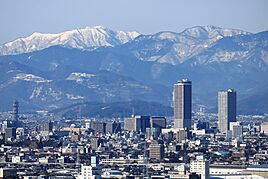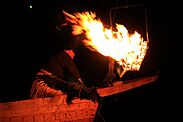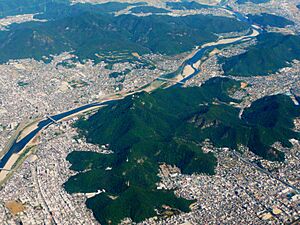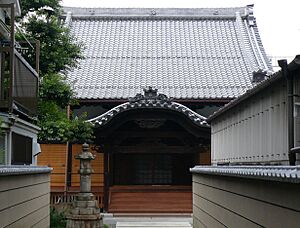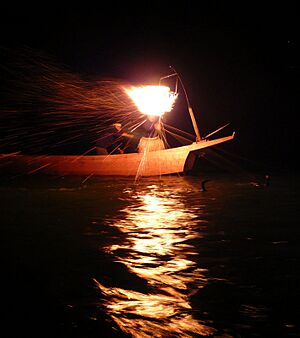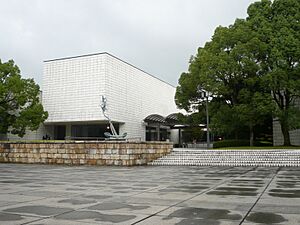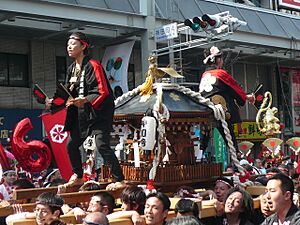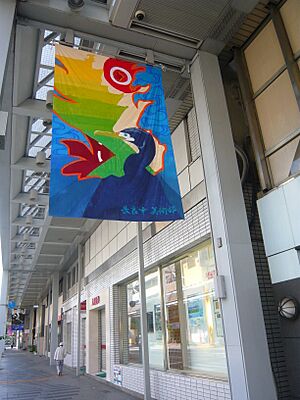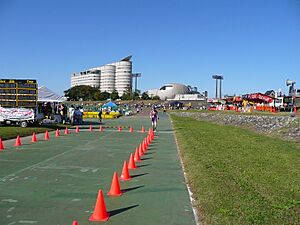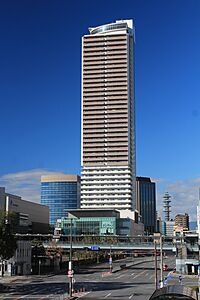Gifu facts for kids
Quick facts for kids
Gifu
岐阜市
|
|||||||||
|---|---|---|---|---|---|---|---|---|---|
|
|||||||||
|
|||||||||
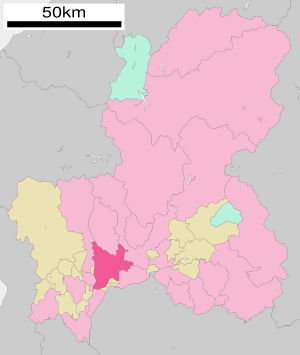
Location of Gifu in Gifu Prefecture
|
|||||||||
| Country | Japan | ||||||||
| Region | Chūbu (Tōkai) | ||||||||
| Prefecture | Gifu | ||||||||
| Area | |||||||||
| • Total | 203.60 km2 (78.61 sq mi) | ||||||||
| Population
(September 1, 2020)
|
|||||||||
| • Total | 400,118 | ||||||||
| • Density | 1,965.22/km2 (5,089.89/sq mi) | ||||||||
| Time zone | UTC+9 (Japan Standard Time) | ||||||||
| City symbols | |||||||||
| - Tree | Japanese Chinquapin | ||||||||
| - Flower | Scarlet Sage | ||||||||
| Phone number | 0581-22-2111 | ||||||||
| Address | 18 Imazawa-chō, Gifu-shi, Gifu-ken 500-8701 | ||||||||
Gifu (岐阜市, Gifu-shi) is a city in the middle of Japan. It is the capital of Gifu Prefecture. This city has been important throughout Japan's history because of its central location.
During the Sengoku period (a time of civil war), powerful leaders like Oda Nobunaga used Gifu as a base. They wanted to unite and control all of Japan. Even after Japan was united, Gifu continued to grow. It was a key stop along the Edo period Nakasendō road and later became a center for fashion. Today, the Japanese government recognizes Gifu as a special "core city."
Contents
About Gifu City
Gifu is located on the flat land near the Nagara River. The city uses its natural surroundings for traditional jobs like making Mino washi (a type of paper) and farming. It also offers fun tourist activities like cormorant fishing.
Mount Kinka is a famous symbol of Gifu. It has a protected forest and Gifu Castle. This castle is a copy of the one Nobunaga used to live in. Gifu also has many exciting festivals and events all year long.
Two main train lines connect Gifu to the rest of Japan. The JR Central's Tōkaidō Main Line links Gifu to Nagoya, a very large city nearby. You can also take a direct train from Gifu to Chubu Centrair International Airport. Gifu is also connected to six sister cities around the world.
As of June 1, 2019, Gifu had about 401,534 people living in 178,246 homes. The city covers an area of about 203.60 square kilometers (78.61 sq mi).
Gifu City Views
Geography of Gifu
Gifu city is in the southern part of Gifu Prefecture, on the northern edge of the Nōbi Plain. The city has grown a lot over time by joining with nearby towns like Kanō (in 1940) and Yanaizu (in 2006). This means Gifu has many different types of land. You can find busy city areas, but also farms with persimmon and strawberry plants.
The northern part of the city has tree-covered mountains. Most of the city center is in the southern part. The Nagara River flows through the city, dividing it in half. Much of Gifu is part of the Nagara River's flat flood plain. This area is great for farming. However, it can flood when typhoons or heavy storms happen. To help with this, dikes and levies have been built to control the water.
Gifu's Climate
Gifu has different weather throughout the year. Summers are hot and humid, while winters are mild. The average temperature in Gifu is 15.5°C (59.9°F). September is usually the wettest month.
The highest temperature ever recorded in Gifu was 39.8°C (103.6°F) in August. The lowest was -14.3°C (6.3°F) in January.
| Climate data for Gifu (1991−2020 normals, extremes 1883−present) | |||||||||||||
|---|---|---|---|---|---|---|---|---|---|---|---|---|---|
| Month | Jan | Feb | Mar | Apr | May | Jun | Jul | Aug | Sep | Oct | Nov | Dec | Year |
| Record high °C (°F) | 20.4 (68.7) |
22.2 (72.0) |
25.8 (78.4) |
30.8 (87.4) |
33.7 (92.7) |
36.5 (97.7) |
39.6 (103.3) |
39.8 (103.6) |
37.7 (99.9) |
32.4 (90.3) |
26.7 (80.1) |
22.1 (71.8) |
39.8 (103.6) |
| Mean daily maximum °C (°F) | 9.1 (48.4) |
10.3 (50.5) |
14.2 (57.6) |
20.0 (68.0) |
24.7 (76.5) |
27.8 (82.0) |
31.6 (88.9) |
33.4 (92.1) |
29.2 (84.6) |
23.6 (74.5) |
17.5 (63.5) |
11.6 (52.9) |
21.1 (70.0) |
| Daily mean °C (°F) | 4.6 (40.3) |
5.4 (41.7) |
9.0 (48.2) |
14.5 (58.1) |
19.4 (66.9) |
23.2 (73.8) |
27.0 (80.6) |
28.3 (82.9) |
24.5 (76.1) |
18.7 (65.7) |
12.5 (54.5) |
7.0 (44.6) |
16.2 (61.2) |
| Mean daily minimum °C (°F) | 0.7 (33.3) |
1.2 (34.2) |
4.2 (39.6) |
9.4 (48.9) |
14.6 (58.3) |
19.3 (66.7) |
23.5 (74.3) |
24.6 (76.3) |
20.8 (69.4) |
14.5 (58.1) |
8.1 (46.6) |
3.0 (37.4) |
12.0 (53.6) |
| Record low °C (°F) | −14.3 (6.3) |
−13.7 (7.3) |
−6.7 (19.9) |
−2.8 (27.0) |
1.7 (35.1) |
6.8 (44.2) |
12.8 (55.0) |
14.0 (57.2) |
8.3 (46.9) |
0.8 (33.4) |
−2.4 (27.7) |
−8.7 (16.3) |
−14.3 (6.3) |
| Average precipitation mm (inches) | 65.9 (2.59) |
77.5 (3.05) |
132.4 (5.21) |
162.4 (6.39) |
192.6 (7.58) |
223.7 (8.81) |
270.9 (10.67) |
169.5 (6.67) |
242.7 (9.56) |
161.6 (6.36) |
87.1 (3.43) |
74.5 (2.93) |
1,860.7 (73.26) |
| Average snowfall cm (inches) | 14 (5.5) |
10 (3.9) |
1 (0.4) |
0 (0) |
0 (0) |
0 (0) |
0 (0) |
0 (0) |
0 (0) |
0 (0) |
0 (0) |
9 (3.5) |
34 (13) |
| Average precipitation days (≥ 0.5 mm) | 9.0 | 9.3 | 10.4 | 10.5 | 10.9 | 12.6 | 13.8 | 10.7 | 12.5 | 9.6 | 7.8 | 10.1 | 127.2 |
| Average relative humidity (%) | 66 | 62 | 58 | 59 | 63 | 70 | 73 | 69 | 70 | 67 | 67 | 68 | 66 |
| Mean monthly sunshine hours | 161.3 | 165.7 | 196.2 | 200.0 | 205.4 | 160.1 | 166.5 | 202.4 | 163.7 | 172.8 | 158.8 | 155.6 | 2,108.6 |
| Source: Japan Meteorological Agency | |||||||||||||
Neighboring Cities and Towns
Gifu is surrounded by several other cities and towns in Gifu Prefecture:
- Ōgaki
- Motosu
- Seki
- Yamagata
- Mizuho
- Hashima
- Kakamigahara
- Kasamatsu
- Ginan
- Kitagata
Gifu's Population
When Gifu became a city in 1889, it was small. It grew steadily as Japan became more industrial. In the 1930s, Gifu became an important industrial center and its population grew very quickly.
After World War II, Gifu continued to do well. However, like many Japanese cities, its population started to shrink in the 1980s and 90s. More recently, the population has increased. This is partly because the town of Yanaizu joined Gifu, adding about 13,000 people. Also, over 9,000 foreign residents live in Gifu, contributing to its growth.
As of July 2011, Gifu had about 412,895 people. There were more females (216,133) than males (196,762). About 21.67% of the population was over 65 years old, while only 14.13% were younger than 15. This is similar to the rest of Japan. The average age of people in Gifu is 43.37 years old. In 2022, Gifu's population was 401,779.
| Historical population | ||||||||||||||||||||||||||||||||||||||||||||||
|---|---|---|---|---|---|---|---|---|---|---|---|---|---|---|---|---|---|---|---|---|---|---|---|---|---|---|---|---|---|---|---|---|---|---|---|---|---|---|---|---|---|---|---|---|---|---|
|
|
|||||||||||||||||||||||||||||||||||||||||||||
Gifu's History
Archaeological sites in Gifu show that people have lived here since ancient times. This is because Gifu is located in the fertile Nōbi Plain. Large burial mounds from the late-Yayoi period (when rice farming began) have been found. Over time, permanent villages appeared. One of these, Inokuchi, eventually grew into the modern city of Gifu.
The Sengoku Period: Unifying Japan
During the Sengoku period (15th to 17th century), a saying was, "Control Gifu and you control Japan." This was because Gifu's central location made it a key spot for leaders trying to unite the country.
For over 200 years, the Mino Province (which includes Gifu) was ruled by the powerful Toki clan. But during the Sengoku period, Saitō Dōsan, a Toki clan follower, rebelled. He took control of Mino Province in 1542. He built Inabayama Castle on top of Mount Inaba. From there, he began his own quest to unite Japan.
Dōsan's daughter, Nōhime, married Oda Nobunaga. Nobunaga was the heir of a rising family in the nearby Owari Province. The idea was for the two families to form a strong alliance. However, Nobunaga eventually took over Dōsan's Saitō clan in the mid-1500s.
It was during Nobunaga's rule that the area got its modern name. In 1567, after talking with a Buddhist priest, Nobunaga renamed the village and Mino Province to Gifu. The first part of the name (岐 gi) comes from Qishan (岐山), a legendary mountain in China where an ancient dynasty began. The second part (阜 fu) means "base of the mountain" and comes from Qufu (曲阜), the birthplace of Confucius.
Nobunaga chose Dōsan's castle and mountain as his main base. He renamed them Gifu Castle and Mount Kinka, respectively. In 1586, a large earthquake, the 1586 Tenshō earthquake, hit the region. It caused many deaths.
Gifu's economy grew a lot during this time. This was mainly because it was at the center of Nobunaga's growing empire. Nobunaga also created a free market called Rakuichi Rakuza (楽市楽座). This helped local businesses thrive. A Portuguese missionary named Luís Fróis visited Gifu and called it a "bustling Babylon" because it was so lively.
Edo and Meiji Periods
After Nobunaga's death, Gifu continued to grow during the Edo period. This was helped by the Nakasendō, one of the main roads of the Tokugawa shogunate. Even though the road didn't go directly through Gifu, nearby towns like Kanō-juku and Gōdo-juku brought a lot of trade. These towns later became part of Gifu city.
Gifu officially became a city on July 1, 1889. It had about 25,750 people and covered 10 square kilometers (3.9 sq mi). Just two years later, on October 28, 1891, a huge earthquake called the 1891 Mino–Owari earthquake struck. About 37% of the city was destroyed by fire. There were 1,505 casualties, with 245 people dying and 1,260 injured. Over 6,300 buildings were affected.
Because of this disaster, Gifu built the first Earthquake Memorial Hall in Japan. It holds memorial services for the victims every month. Gifu recovered from the earthquake damage by the end of the Meiji period. By 1911, it was strong enough to start its own streetcar service.
World War II and Modern Gifu
In 1940, Gifu grew by taking in the former town of Kanō. Kanō had many traditional businesses, which helped Gifu's industries. During World War II, Gifu was a major industrial center. This was partly because the nearby city of Kakamigahara was an important aviation hub.
Because of its industrial importance, Gifu was heavily bombed by the United States Army Air Forces. The worst attack was the Gifu Air Raid on July 9, 1945. This raid caused 1,383 casualties (863 dead, 520 injured) and damaged over 20,000 buildings. Gifu remembers these events every year on July 9 with a Peace Bell ringing at temples.
During the war, Gifu was also where Japan made its fire balloons. These were paper hot air balloons carrying bombs, meant to cause trouble in America. Local high school girls made these balloons from Mino washi (a strong Japanese paper) and konnyaku paste.
After the war, Gifu faced another challenge. On September 12, 1976, Typhoon 17 hit the city. It killed five people and affected over 40,000 families. However, Gifu recovered again by developing various local industries.
In 1996, the national government named Gifu a "core city." As its fashion industry has slowed down, Gifu has been focusing on manufacturing to boost its economy. Recent construction, especially around JR Gifu Station, has also helped the city's economy. Gifu City Tower 43 is an example of this growth. In 2006, Gifu expanded its size by merging with the town of Yanaizu.
International Connections
Gifu has special relationships with cities around the world. These are called "sister cities" or "friendship cities."
Sister Cities
 Campinas, State of São Paulo, Brazil (since 1982)
Campinas, State of São Paulo, Brazil (since 1982) Cincinnati, Ohio, United States (since 1988)
Cincinnati, Ohio, United States (since 1988) Meidling (Vienna), Austria (since 1994)
Meidling (Vienna), Austria (since 1994) Thunder Bay, Canada (since 2007)
Thunder Bay, Canada (since 2007)
Friendship Cities
National Sister City
Gifu's Economy
Gifu's first big industry was textiles, which means making fabrics and clothes. For a long time, it was a major leader in Japanese fashion, competing with Tokyo and Osaka. Near JR Gifu Station, you can find many small clothing stores. The main covered shopping area, Yanagase, also has many shops selling clothes, shoes, and accessories.
However, Gifu's fashion industry has declined a lot in the last ten years. So, the city has started to develop other industries to support its economy.
One of these new industries is manufacturing. Gifu is close to Aichi Prefecture, which has many large car and heavy industry companies like Toyota. This has made Gifu a good place for companies that make metal parts, molds, and other components. It's easy to get to nearby areas by public transport and highways, which helps factories set up here.
Besides modern industries, Gifu also has many traditional crafts. These include traditional Gifu Fans, Mino washi paper, and foods made from the ayu sweetfish. Many shops in the city sell these items. The most famous local crafts are traditional Gifu Lanterns and Umbrellas. There are about 15 businesses that make lanterns in Gifu. In the Kanō area, visitors can even learn to make their own paper umbrellas.
Education in Gifu
Gifu has many schools for children of all ages.
- There are 48 nursery schools and 43 kindergartens.
- The city runs 47 public elementary schools. There is also one national public elementary school and one private one.
- For junior high, there are 22 public schools, plus one national public and one private junior high.
- Three private schools combine junior and senior high.
- After junior high, students can choose from 12 public high schools (run by Gifu Prefecture) or 5 private high schools.
- There is also a North Korean school called Gifu Korean Elementary and Junior High School.
Gifu also has 19 technical schools and several colleges and universities. The biggest is Gifu University, which is a national university and has a hospital. Other universities include:
- Gifu Pharmaceutical University
- Gifu Shotoku Gakuen University and its junior college
- Gifu Women's University
- Gifu City Women's College
- Gifu Junior College of Health Science
- Heisei College of Health Sciences
Getting Around Gifu
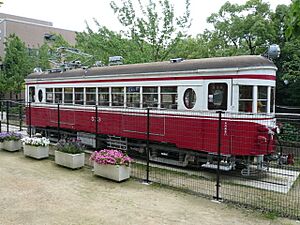
Gifu's central location and its history as a stop on the Nakasendō make it an important transportation hub. Many train and bus lines pass through the city. Nine national highways also run through Gifu, including the Meishin Expressway and Tōkai-Kanjō Expressway.
Train Travel
Two main train companies have stations downtown: JR Central and Meitetsu.
- The JR Tōkaidō Main Line runs through Gifu. The Takayama Main Line starts at JR Gifu Station.
- The fastest train, the JR Tōkaidō Shinkansen, does not stop directly in Gifu. Its closest stops are Nagoya Station and Gifu-Hashima Station.
- Meitetsu lines include the Nagoya Line, the Kakamigahara Line, and the Takehana Line. All of these start at Meitetsu Gifu Station.
- ■Tōkaidō Main Line: - Gifu -Nishi-Gifu
- ■Takayama Main Line: - Gifu - Nagamori
- ■ Tōkaido Main Line: Gifu Freight Terminal
- ■Nagoya Line: Chajo - Kanō - Meitetsu Gifu
- ■Kakamigahara Line: Meitetsu Gifu - Tagami - Hosobata - Kiridōshi - Tejikara - Takadabashi
- ■Takehana Line: Yanaizu
Meitetsu also used to run a streetcar line through Gifu until April 1, 2005.
Bus Service
Bus service in Gifu started in 1949. Today, Gifu Bus Co., Ltd. provides service within the city and to other cities. Their highway buses connect Gifu with places like Gujō, Osaka, Kobe, Kyoto, and Shinjuku in Tokyo. All local bus lines pass through JR Gifu Station.
Bicycle Rentals
You can also explore Gifu by bicycle! The city has a bike rental program to help tourists. You can rent bikes at:
- JR Gifu Station (second floor)
- Gifu City Hall (South Branch)
- Gifu Park (Museum of History)
- The Cormorant Fishing Boat Viewing Office
Things to See and Do in Gifu
Cormorant Fishing
Cormorant fishing is Gifu's most famous tourist attraction. While it happens in other parts of Japan, cormorant fishing on the Nagara River has been done for over 1,300 years. It's the biggest display of cormorant fishing in Japan. Six fishing masters go down the river at the same time, using their birds to catch ayu sweetfish.
The fishing season runs from May 11 to October 15 every year. It happens every night, unless the water levels are too high or during the harvest moon.
Famous haiku poet Matsuo Bashō spent months in Gifu, writing poems about cormorant fishing. Even the famous comedian Charlie Chaplin came to watch it twice and was very impressed.
Museums to Explore
The largest museum run by the city is the Gifu City Museum of History. It's in Gifu Park and focuses on Gifu's past with many hands-on exhibits. It also hosts special exhibits on different topics.
Also in Gifu Park is the Eizō & Tōichi Katō Memorial Art Museum. This museum shows the works of brothers Eizō and Tōichi Katō, who were famous artists from Gifu Prefecture. Many of their paintings feature the Nagara River and cormorant fishing. The Yanaizu Folklore Museum is another branch of the history museum.
There are two more museums in Gifu Park:
- The Nawa Insect Museum, next to the history museum, was started by Yasushi Nawa, Japan's "Insect Man," in 1919. It offers a close look at insects.
- The Gifu Castle Archive Museum is next to Gifu Castle on Mount Kinka.
Other museums include the Gifu City Science Museum and the Museum of Fine Arts, Gifu.
- The Science Museum has general exhibits, a planetarium, and a rooftop observatory.
- The prefectural Museum of Fine Arts opened in 1982. It features art and artists connected to Gifu Prefecture, as well as art from around the world.
Since 2006, elementary and junior high school students can enter many of Gifu's museums for free!
Festivals and Events
Gifu has many exciting festivals throughout the year.
- The Dōsan Festival and the Gifu Festival both happen on the first Saturday and Sunday of April. The Dōsan Festival honors Saitō Dōsan near where he is buried. The Gifu Festival is a Shinto festival that starts at Inaba Shrine. Both festivals have street vendors, flea markets, and parades with floats.
- The Gifu Nobunaga Festival takes place on the first Saturday and Sunday of October. It honors Oda Nobunaga and includes a parade of horses and warriors through the city streets.
Gifu also celebrates its cultural heritage with special events:
- The Tejikara Fire Festival happens twice a year: on the second Saturday of April at Tejikarao Shrine, and on the second Sunday of August at Nagara River Park. Men ring bells and carry special devices that shoot out large sparks.
- In late August, the city hosts Takigi Noh. This is a traditional Japanese theater performance held on the banks of the Nagara River. It's lit only by bonfires and the fires from cormorant fishing boats.
Gifu also hosts two large fireworks festivals. Many visitors gather on the banks of the Nagara River to watch these huge displays.
- The first, the Chunichi Shimbun Nagara River All-Japan Fireworks Festival, is on the last Saturday of July.
- The second, the Nagara River National Fireworks Display, is on the first Saturday of August.
About 30,000 fireworks are set off at each festival!
The downtown area often hosts Flag Art Exhibitions. Large flags (about 3 by 1.8 meters or 10 by 6 feet) are displayed. Each exhibition has a different theme, like the beauty of Gifu or AIDS Awareness. Sometimes, local students or artists create the flags.
Sports and Athletics
The main sports complex in Gifu is the Gifu Memorial Center. It has facilities for many sports, including:
- A track and field area
- A baseball stadium
- Tennis and swimming areas
- Facilities for martial arts and traditional arts
There are also two large multi-purpose domes: the Deai Dome (seats 5,000) and the Fureai Dome (seats 700). All facilities can be used at night. The soccer field at the Memorial Center is home to FC Gifu, the city's football team in the J-League.
Next to the Memorial Center is the Nagaragawa Sports Plaza. This center helps athletes improve their skills.
Just south of these sports facilities is the Naoko Takahashi Road. This walking path runs along the Nagara River. It's named after Naoko Takahashi, a marathon runner from Gifu who won a gold medal at the 2000 Summer Olympics. This road is used for events like the Terry Fox Run and the Nagaragawa International Inline Skating Competition.
Other Fun Places to Visit
Gifu Park is a major tourist spot. It has many museums and is close to other attractions. It's also a great place to relax with shaded areas, ponds, waterfalls, cherry trees, and wisteria vines.
Next to Gifu Park is Mount Kinka. This mountain is a main symbol of Gifu. It rises 329 meters (1,079 ft) along the Nagara River. Gifu Castle is on top of it, and there are many hiking trails.
Other attractions include:
- Bairin Park: This park is full of over fifty types of plum trees. They bloom in beautiful colors from white to dark pink every spring.
- Nagaragawa Onsen: This is a popular indoor spot with many onsen (hot springs) and ryokan (traditional Japanese inns). They are located along the Nagara River. The springs have a lot of iron, which is thought to be good for health.
- Mount Dodo and Matsuo Pond: Mount Dodo is the tallest mountain in Gifu, at 418 meters (1,371 ft). It has hiking trails and offers views of Mount Haku and the Nagara River. Matsuo Pond, at the base of the mountain, is popular in the fall when the leaves change colors.
The Yanagase covered shopping arcade used to be Gifu's main shopping area. It has many small shops, restaurants, and department stores like Takashimaya and Muji. It also has two movie theaters. Yanagase became famous across Japan because of Kenichi Mikawa's hit song, "Yanagase Blues," in the 1960s.
Historical Sites
Castles of Gifu
Gifu's most famous castle is Gifu Castle, on Mount Kinka. It was first built by the Nikaidō clan during the Kamakura period. The castle has been rebuilt many times, with the current version finished in 1956.
One of its first residents was Saitō Dōsan, when it was called Inabayama Castle. The next owner, Oda Nobunaga, changed the castle's name to Gifu Castle. From the top of the castle, you can see 360 degrees around the city. Inside, there are many old items from its past.
The other two castles in Gifu, Kanō Castle and Kawate Castle, are now just ruins. But they were very important in the city's history.
- Kanō Castle was built after the Battle of Sekigahara. Tokugawa Ieyasu ordered the Toyotomi family to build it on the ruins of an older castle. Its citadel ruins are now a National Historic Site.
- Kawate Castle was used by the Toki clan. It was also a meeting place for important cultural and social people from Kyoto. A stone monument marks its location near Seibi High School.
Important Shrines
The most famous shrines in Gifu are Inaba Shrine, Kogane Shrine, and Kashimori Shrine. They are considered a family of shrines because their gods are related.
- Inaba Shrine was originally on the north side of Mount Kinka. Saitō Dōsan moved it to its current spot.
- Kogane Shrine is in Kogane Park.
- A legend says you can see the footprints of Tenba, a mythical horse, behind Kashimori Shrine.
Kanō Tenman-gū, in the old Kanō-juku area, was built around the same time as Kanō Castle. It was a place of worship for the castle's residents and later for many people in the growing town. Tejikarao Shrine, in the eastern part of the city, is famous for hosting the Tejikara Fire Festival in April. Gifu also has seven of the Mino Thirty-three Kannon temples.
Major Temples
Many of Gifu's temples have strong connections to Saitō Dōsan and Oda Nobunaga.
- Jōzai-ji was built by Saitō Myōchin, an ancestor of Dōsan. Dōsan's remains are buried here.
- Zuiryō-ji was also built by Myōchin and holds the tombs of important historical figures.
- Sōfuku-ji has a "Blood Ceiling." This ceiling was stained with the blood of warriors who died during the Battle of Sekigahara. This temple also has the tombs of Oda Nobunaga and his son, Oda Nobutada.
Shōhō-ji is home to the Gifu Great Buddha, also called the "Blessed Buddha." Built during the Edo period, it was the first and largest dry-lacquered Buddha in Japan. It is still one of Japan's three largest Great Buddha statues. The Buddha and its bamboo frame took 38 years to build.
Jōdo-ji holds the remains of Hanako, who was the only Japanese model for the famous artist Auguste Rodin. A statue of Hanako was put up at the temple in 2004.
Gifu's Culture and Lifestyle
The central part of Gifu acts like an extension of nearby Nagoya. Nagoya has large offices for many international companies, like Toyota. It's easy to travel between the two cities, and many new apartments are being built in Gifu.
Just west of Gifu Station is Gifu City Tower 43. This is a 43-story building that opened in 2007. It's the tallest building in Gifu Prefecture. The top 30 floors have apartments, including some for senior citizens. The lower floors are used for offices and shops, like medical clinics. There's also a public area at the top of the building, offering another 360-degree view of Gifu, just like from Gifu Castle.
Gifu city is currently promoting the Slow Life City Initiative. This idea encourages people to live a slower, more relaxed lifestyle. It's similar to the "slow food" movement, but it covers more areas of life. The main goals of this initiative include:
- Relying more on food grown locally.
- Enjoying traditional culture and arts.
- Encouraging people to get more involved in their community.
Besides slow food, Gifu also hopes to include "slow industry" (traditional crafts), "slow education" (learning about quality of life), and "slow tourism" (like cormorant fishing).
Famous People from Gifu
Politicians
- Yasuhiko Funago
- Hajime Furuta
- Iwao Matsuda
- Yoji Muto
- Seiko Noda
- Yasuhiro Sonoda
- Atsuko Wakai
Culture and Arts
- Haruka Aizawa - manga artist
- Eizō Katō - painter
- Tōichi Katō - painter
- Nobuo Kojima - writer
- Seijirō Kōyama - film director
- Makoto Raiku - manga artist
- Aki Shimazaki - writer (moved to Canada in 1981)
- Masahiro Shinoda - film director
- Morita Sōhei - novelist
- Masamitsu Tsuchida - Go player
- Kansai Yamamoto - fashion designer
Entertainment
- Gō Ayano - actor
- Yu Hasebe - actress
- Miona Hori - idol, Nogizaka46
- Hideaki Itō - actor
- Mina - voice actress
- Nana Okada - singer
- Reina Sumi - announcer
- Shinnosuke Tachibana - voice actor
Athletes
- Sayaka Aoki - track and field
- Takahiro Aoki - former baseball player
- Yuko Arai - fencer
- Kenta Asakura - former baseball player
- Shinji Iwata - former baseball player
- Masaaki Mori - former baseball player and manager
- Yasuyuki Moriyama - former football player
- Tomoko Okuda - professional boxer
- Toru Suzuki - golfer
- Morimichi Takagi - former baseball player
- Jumpei Takahashi - baseball player, Fukuoka SoftBank Hawks
- Naoko Takahashi - long-distance runner
- Hiroshi Tanahashi - wrestler
- Tsuyoshi Tezuka - drifting driver
- Kazuhiro Wada - former baseball player
Others
- Kenkichi Kagami - entrepreneur
- Takeyoshi Kawashima - jurist
- Hirosi Ooguri - physicist
See also
 In Spanish: Gifu (Gifu) para niños
In Spanish: Gifu (Gifu) para niños


